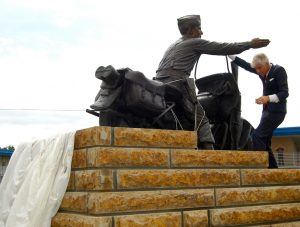Hundreds gather for Darby statue dedication, ‘welcome him back in triumph’
by April 30, 2016 1:25 pm 1,409 views
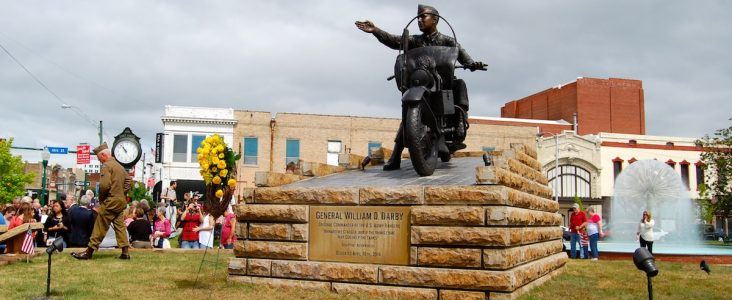
William Darby wrote in a school essay he would be “something great” or a “professional bum.” It was the former, and several hundred people gathered Saturday morning in downtown Fort Smith to dedicate a statue honoring the native son credited with creating the U.S. Army Rangers.
Saturday’s (April 30) event at Cisterna Park in downtown Fort Smith marked the end of several years of work by the General Darby Legacy Project to place a statue of the Fort Smithian who died at the age of 34 in the final days of World War II. Liz and Joe Armstrong are widely credited for the initial push and often the driving push for the Darby statue. Joe is a retired Army Ranger.
DARBY’S FINAL DAYS
On April 23, 1945, during the waning days of World War II, Colonel William Orlando Darby found himself with an unexpected mission. Robinson Duff, the Brigadier General and assistant commander of the U.S. 10th Mountain Division, was wounded in an enemy attack leaving it to the already-highly decorated Darby to take over and lead his “Task Force Darby” to the Po River valley bridgehead in Italy.
While conferring with his men one week after assuming command, Darby was one of two killed by an 88mm enemy shell that burst in the middle of the assembled officers and non-commissioned officers (NCOs). Several others were injured. Task Force Darby continued on with the mission, and two days later, all German forces in Italy surrendered.
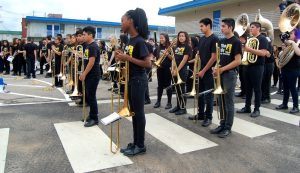
The Colonel was posthumously promoted to Brigadier General just 15 days after his death and was buried in Cisterna, Italy, Fort Smith’s sister city. Four years later, the body was exhumed and reinterred at Fort Smith National Cemetery.
General Darby is credited with creating, organizing, and leading the first corps of Army Rangers – called “Darby’s Rangers,” and immortalized in a film of the same name starring James Garner as Darby. He was also known for riding a motorcycle during his service in Europe.
ANSWERING THE CALL OF HISTORY
Darren McKinney, principal of Darby Junior High School in Fort Smith and chairman of the Darby Legacy Project Committee, told the several hundred gathered in and around the small park that the committee’s goal was to “tell the story of a great man, and the community was willing to listen.” He also said Darby is a “constant reminder of what leaders can do when they are truly asked to lead.”
Kevin Kresse, the Little Rock-based sculptor commissioned to create the 2,500-pound Darby statue, said Darby was not a person put in a special position, but was a special person put in a position. He said all of Darby’s background, from childhood to being a West Point graduate, created a person who was at the right place at the right time during a critical “arc of history.”
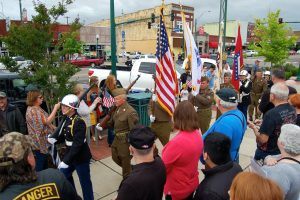
“When he received that call from history, history was made,” Kresse said.
Major General William Wofford, a retired adjutant general with the Arkansas National Guard, who along with his son was a Ranger, told the crowd that after he saw the movie “Darby’s Rangers,” he idolized Darby and knew then he wanted to be a Ranger. Wofford, who was born and raised in Clarksville, Ark., was also a trained field artillery officer, as was Darby. Wofford’s first son is named William Darby Wofford.
‘WELCOMING HIM BACK IN TRIUMPH’
Darby Watkins, a nephew of Darby, said the family remembers the young Darby as “spirited” and “impulsive,” adding that Darby’s mother broke many hairbrushes trying to discipline him. She would eventually learn to hug him until the desire to spank him subsided, Watkins said. It was that somewhat rebellious spirit and energy that helped him survive West Point and be a leader on the battlefield, Watkins said.
He also told the Darby Junior High band members who played before the ceremony and would lead the crowd in reciting the Ranger pledge, that “William O. Darby should be remembered because he is one of you.”
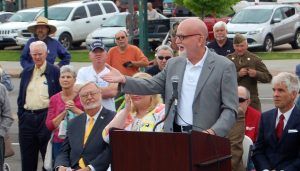
Watkins said the Darby family is grateful for being part of the Legacy project and proud of the community support.
“Thank you Fort Smith for welcoming him back in triumph,” Watkins said.
When the monument was unveiled, Army veteran Kenneth Vaught gave the “First Salute.” Vaught was a member of the burial detail that returned Darby’s body to be buried in the Fort Smith National Cemetery. Vaught provided the ceremonial final salute at that service.
Among the many active and inactive Rangers attending was Wilbur Gallup, who was part of the Darby Rangers during fighting in North Africa. Following Vaught’s first salute, Gallup gave the orders for all the Rangers in attendance to salute the Darby statue.
